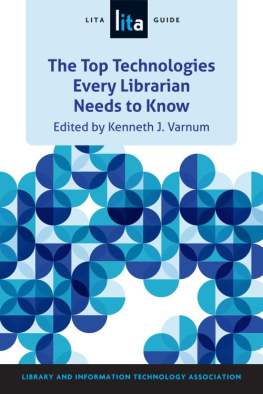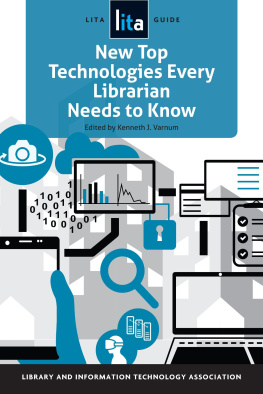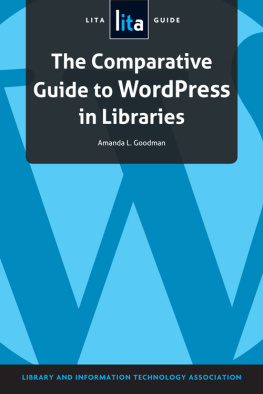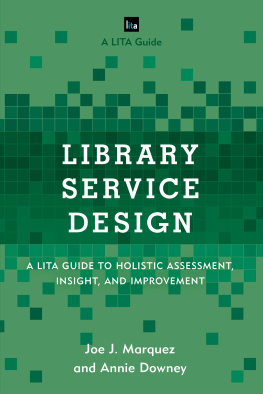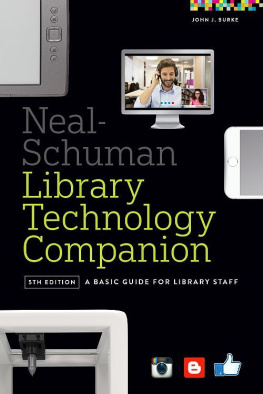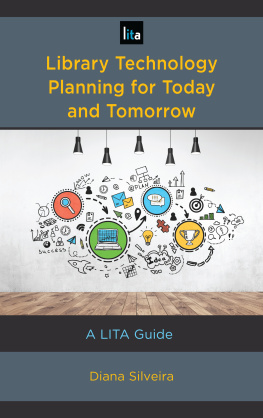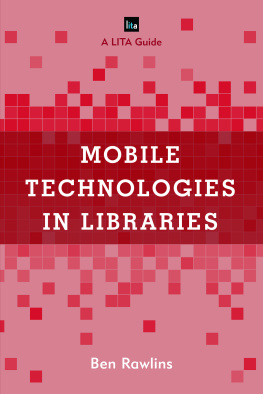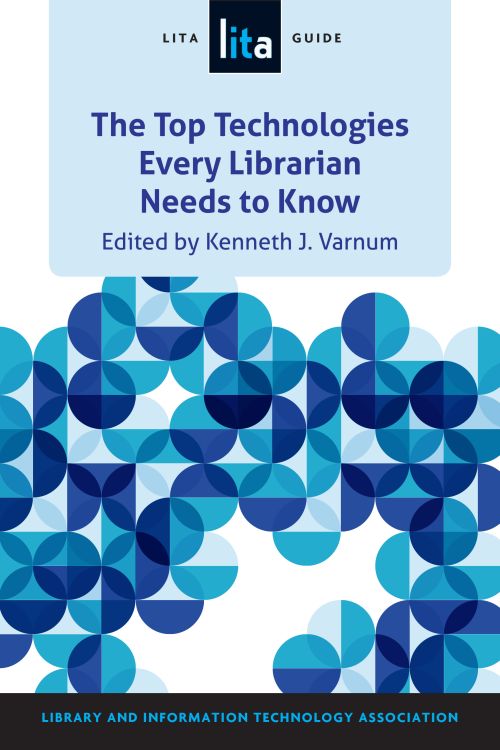
ALA TechSource purchases fund advocacy, awareness, and accreditation programs for library professonals worldwide.
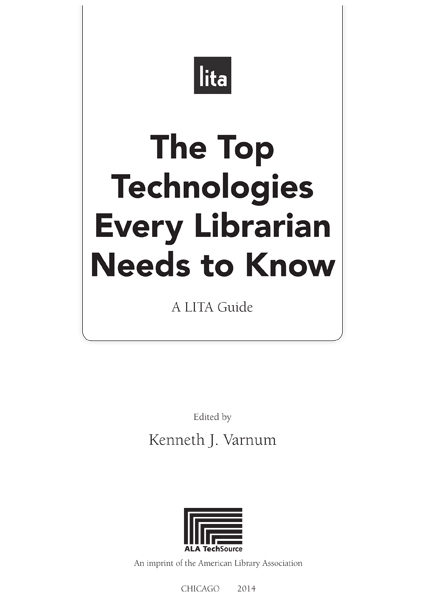
2014 by the American Library Association. Any claim of copyright is subject to applicable limitations and exceptions, such as rights of fair use and library copying pursuant to Sections 107 and 108 of the U.S. Copyright Act. No copyright is claimed for content in the public domain, such as works of the U.S. government.
Extensive effort has gone into ensuring the reliability of the information in this book; however, the publisher makes no warranty, express or implied, with respect to the material contained herein.
ISBNs: 978-0-8389-1228-7 (paper); 978-0-8389-1965-1 (PDF); 978-0-8389-1966-8 (ePub); 978-0-8389-1967-5 (Kindle). For more information on digital formats, visit the ALA Store at alastore.ala.org and select eEditions.
Library of Congress Cataloging in Publication Data
Varnum, Kenneth J., 1967
The top technologies every librarian needs to know / Kenneth J. Varnum.
pages cm.(A LITA Guide)
Includes bibliographical references and .
ISBN 978-0-8389-1228-7 (alk. paper)
1. LibrariansEffect of technological innovations on. 2. Library employeesEffect of technological innovations on. 3. Technological literacy. 4. LibrariansIn-service training. 5. Library employeesIn-service training. 6. Library education. 7. Information technologyStudy and teaching. I. Title.
Z682.35.T43V37 2014
025.5'2dc23
2014006157
Contents
A. J. Million and Heather Lea Moulaison
Brigitte Bell and Terry Cottrell
William Denton
Steven K. Bowers and Elliot J. Polak
Kenneth J. Varnum
Anson Parker, V. P. Nagraj, and David Moody
Devin Higgins
Jeremy York
Jason Griffey
E veryone wants a crystal ball to help divine where to make investments in resources, technology, and time, so as to be better positioned to take advantage of whatever it is the future brings. Libraries are no different. This book was born of that desire, tempered by a dose of practical reality.
In a landscape where tools and trends change in a heartbeat, how can a library technologist know what has staying power and might well be the next big thing, worthy of serious attention? In this book, we have gathered experts on a range of emerging technologies to talk about just that. To avoid deus-ex-machina solutions to all our challenges, I asked the contributors to this book to stick to a near-term future, three to five years awayclose enough to be in the realm of the predictable, but far enough away to ensure that the path to the future is not already paved.
Each chapter includes a thorough description of a particular technology: what it is, where it came from, and why it matters. We will look at early adopters or prototypes for the technology to see how it could be used more broadly. And then, having described a trajectory, we will paint a picture of how the library of the not-so-distant future could be changed by adopting and embracing that particular technology.
This is not a how-to manual for implementing the technologies, although there is some discussion about the hurdles that might need to be cleared to put each into place. Rather, the focus is on the impact the technology could have on staff, services, and patrons.
ABOUT TECHNOLOGY SELECTION
As you read this book, there are three basic things you should keep in mind as you develop a technology road map for your librarys future: your librarys longer-term goals, needs, and abilities. That is to say, you should look farther down the road than the current years goals and projects, thinking more strategically. You probably are addressing the immediate needs of your library and patrons, or are working hard to do so. What you should be doing is looking farther down the road, seeking to discern what, broadly speaking, a successful version of your library will like.
Goals
The first area is strategic goals. There are many cool, interesting, and exciting technologies that your library could take onwe talk about many of them in this book. The foundation question to focus on, though, is where do you want to be? Technology cannot be the driver of your goals; it must be the enabling agent.
This preliminary question seems simple to answer but in reality is quite challenging. It requires an understanding of your community and where it is going. This is less an expression of what you must do than it is a matter of how you want your library to be characterized. At the same time, setting your librarys goals is a much broader question than selecting technologies. The appropriate responses to your goals may have technological, organizational, and/or staffing answers. Without knowing what the targets are, an attempt to adopt a technology is likely to have, at best, a mixed result.
Depending on where your library is positioned in your larger organization, the degree to which you have autonomy over your own goals can vary. An excellent place to start, if you do not already have a set of strategic goals, is your parent organizations strategic plan. Where does it want to be? And how can you best position yourself to be in the right place?
Needs
Your future needs can be thought of in two parts. The first is related to what your library needs to do to meet the expectations of the community that pays your way (this might be your campus, your school, your community, or your organization). For some, meeting these needs might be the main contingency for continuing to receive funding. For others, meeting these needs is more intrinsicthe library doing its job well is sufficient justification on its own.
The second part of needs is related to what you require to continue delivering services in a cost-effective manner while remaining relevant to that community. The impact of free, always-on information services such as Google and Wikipedia should not drive library actions; but at the same time, offering something that those Internet sites do not is key to staying viable. This involves identifying the areas in which your library provides critical services to your communityaccess to licensed full text content, access to information technology, access to education, or whatever affordances you offerand figuring out which are the ones you want to continue excelling at. If your librarys future budget will be constrained, making a strategic decision to stop maintaining your own ILS could free up funds and staff to develop a digital repository for your community or to invest in digital versions of print materials. Knowing what the needs of community are will help guide you in making decisions to pursue one or another future technology.
Abilities
The third important factor to consider in positioning your library for new technologies is the abilities the people on your staff now have and the abilities you can reasonably acquire. Do you have the necessary staff to implement a new technology? What opportunities do you have to retrain existing staff to manage a new technology, or to acquire new staff to meet future needs? If you do not expect to be able to make significant staffing changes, then retraining becomes the obvious path. If you expect opportunities to hire new staff (either replacing vacant positions with different skill sets or adding new positions), that possibility opens new horizons for adopting radically different technologies than might otherwise be the case.
More broadly than staff abilities is the librarys ability to take on new technologies or services. You could view this from a narrow view of capabilityasking, What skills do we have to bring to bear?but you can also think of this as constitutional capability. Is this a library whose culture readily adopts change or innovation? For example, if your library were to take the philosophically large step of moving to a cloud ILS system, would the people on your staff who are accustomed to near total control over the catalogs contents be able to make the switch?
Next page
